Since my earliest days with the long-lost, late-lamented Blotanical, I’ve been a reader of Loree Bohl’s The Danger Garden. With a focus on her passion for spiky plants, Loree has been a regular and prolific blogger since 2009. Get to know her through this interview.
Now the growing conditions in Portland (USDA Z8) and Toronto (USDA Z5/Canadian Z6) couldn’t differ more. Portland’s Mediterranean climate (mild, rainy winters; warm, dry summers) supports plants that would be unsustainable in our virtually opposite semi-Continental one (warm, humid summers; cold and, more recently, dry winters). I also know that, even with milder temperatures, many Danger Garden plants do spend winter indoors – perhaps to keep the spikies out of the rain? As an inveterate houseplant killer, I couldn’t be trusted to do that.
But those niggling details mean nothing when I look for inspiration. When my real-life taste of Danger happened during the 2014 Garden Bloggers Fling in Portland I was definitely inspired by what I saw. Beginning with…
Potscaping
Just move your eyes around the pictures above and below. Isn’t that a fabulous balance of colours, textures and shapes? My mind’s eye keeps mapping out the interlocking triangles in the opening image as if it were an art appreciation study of The Last Supper. Try it! These two vignettes mirror each other beside the steps to the gazebo (for lack of better word) I’ll look at in a minute. Some people just have The Eye. The more I study, the more I learn.
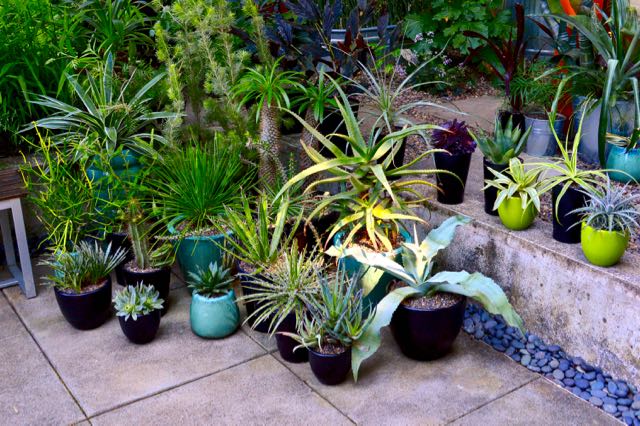
A Focal Point
You can believe I took lots of detail shots of this great covered seating area to bring back to show Mr. “Honey, I Have Something For You To Build” TG. I loved its strong vertical impact, bold colour and yet open, airy feeling, visible from almost everywhere in the garden. A few steps up from the central patio, it was the perfect spot to sit and take in an overview of the garden. Many bloggers did. Patience alone rewarded me with these untenanted views.
It was also handy as a place for hanging plants.
Foliage Pizazz
Not all Loree’s plants would be verboten in my own space. Considering her spiky focus, she’s created some wonderful soft foliage combinations, especially in the shady areas. (Click on the thumbnails to embiggen. For the record, I know the word “enlarge” works just as well, but it isn’t as wonderfully ridiculous.) In fact, she has one my own favourites, the fingery plant in the middle shot, shredded umbrella plant (Syneilesis aconitifolia). Hers grows taller, though.
Of the images below, about the only plant that wouldn’t work in Toronto gardens has the bluish, compound-leaf on the right, a form of Melianthus major (perhaps ‘Antonow’s Blue’, USDA Z8a). Since I first met the green version in Dallas in 2010, under the delightful common name “peanut butter plant” (due to the scent), I’ve reconciled myself to the fact that mine will always be an unrequited love. But blue and yellow? We can do that.
A Touch of Discipline
Straight, squared edges on the beds and linear paving laid on a lightly imposed grid add just the right amount of restraint in a space that in some areas feels junglelike. It makes the garden, which is relatively small, feel organized, not rigid. The garden beds and potscapes are carefully composed, not constrained.
Balance is a word I used in my first point. People sometimes feel they must go all one way or the other – either totally formal or totally loose. It isn’t so. Like the braiding on a Chanel jacket that balances the more bohemian nubbled fabric and ropes of beads, straight lines can add coherence to plantings that are allowed to be a little wild. We tried to do that in our own garden makeover back in 2012 – here you can see the before and after.
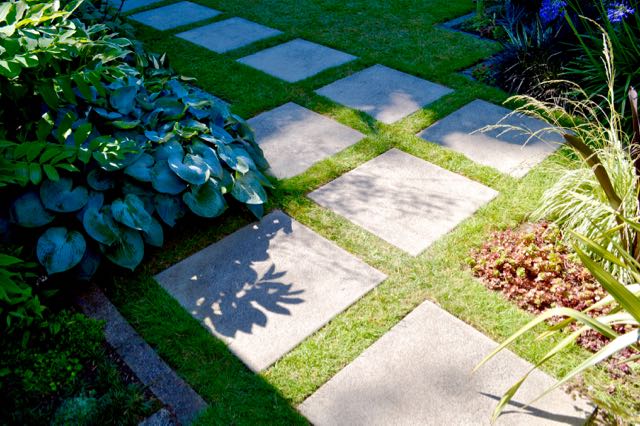
Creative Containers
Are these plates on sticks already planters or are they Loree’s invention? I have no idea. But what a great way to add variety and bring interesting plant pictures closer to eye level. Then look closely at the picture below the picture below for something similar. Is that a funnel? Hmmm.
It always pays to stay alert for a way to reinvent an everyday object – especially when you can stick a plant in it.
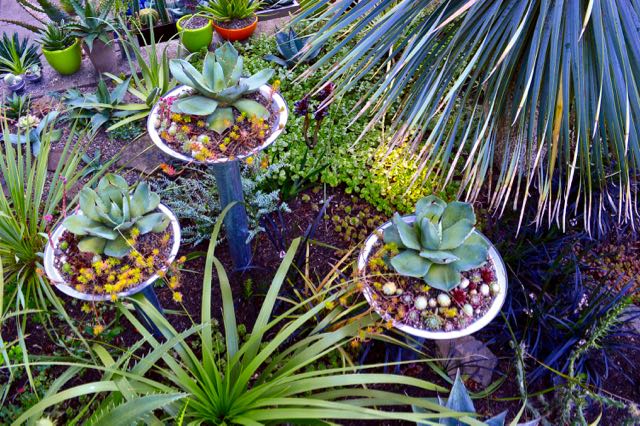
Creative Raised Beds
Any garden can be made more interesting through changes in level. Loree’s use of animal water troughs for height changes (and maybe constraining the spread of those bamboos) was inspired. Her troughs came in different sizes, heights and shapes, including round.
We use two horse troughs to grow vegetables. Now I’m thinking about how to adapt them for perennials. Some modifications for overwintering here will be required. Filing this idea away for when I redesign the Microgarden – which will happen round about the time our cedar shed bites the big one.
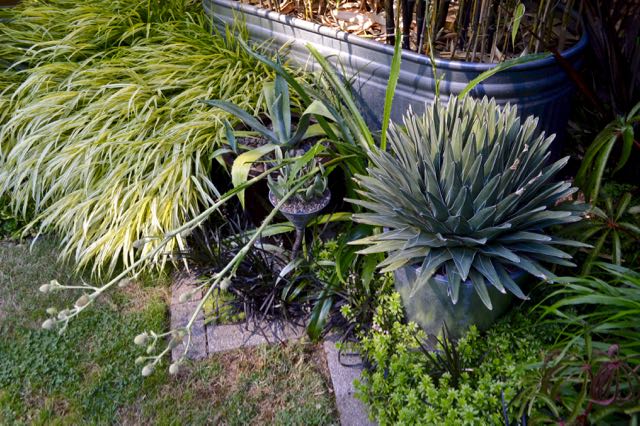
A Living Screen
In the middle of the Danger Garden (or middle-ish) is a large central bed, with spikes galore, that divides the space roughly in two. In an unconventional twist, closest to the house is the lawn, edged in planting beds, and a paved patio perfect for entertaining is at the far end of the garden.
The large bed stretches about two-thirds of the way across the garden, effectively screening one space from the other – as you can see from the two smaller shots below. So what you have is two distinct garden rooms, each with a feeling of enclosure and privacy. Whether your plants are spiky or not, this is a great use of space in a garden.
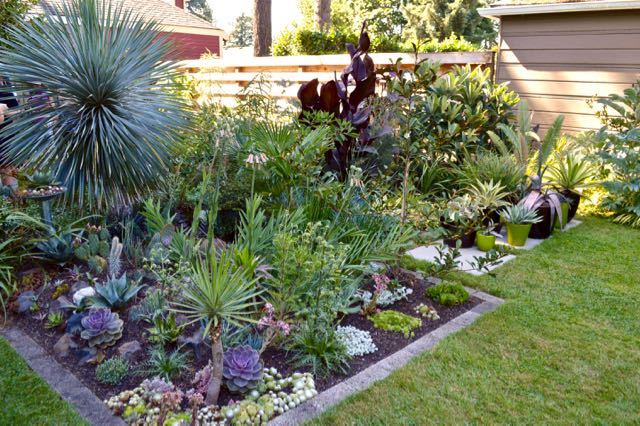
Colour Unity
There are many more takeaways from this garden, but the one I want to focus on last is the consistent use of a limited colour palette in all the garden’s accents: red, black, turquoise, lime green, and grey (often using galvanized metal, or occasionally stone). This was another way to throw a little bit of order into the mix. Sometimes these colours were combined in threes, but every once in a while a single colour appeared to add pop to a grouping.
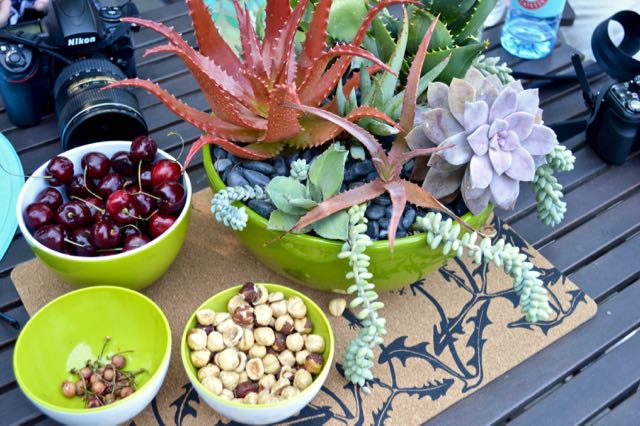
I’ve been planning to write about this garden for a long time. Glad to finally share some of the things that have made me go back and look at my pictures from the Danger Garden again and again. Thank you, Loree, for having us. Sending best wishes for a swift recovery from the storms of early 2017!
As always, clicking on any image will open the slideshow – and the images will look sharper.
Have you used any of these ideas in your garden? Or, if you’ve visited the Danger Garden, what have we missed?

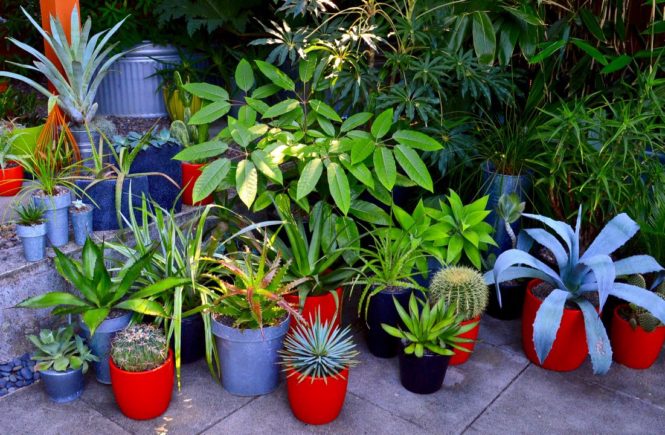
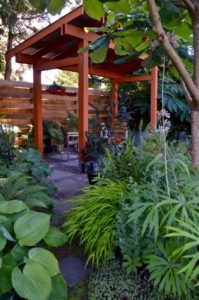
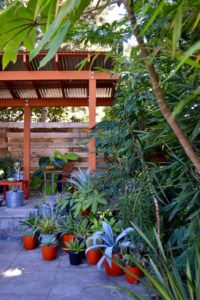
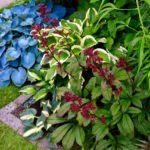
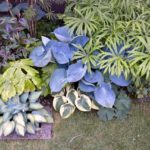
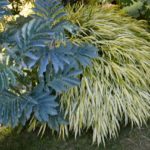
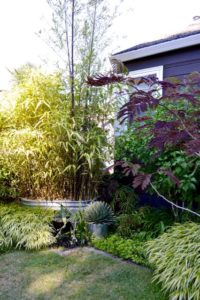
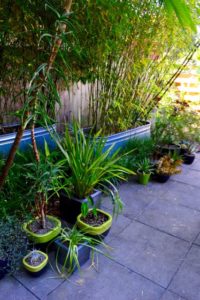
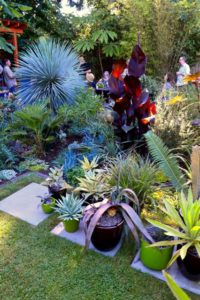
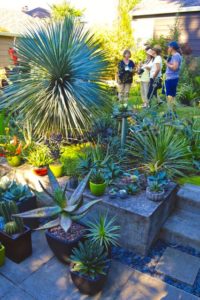
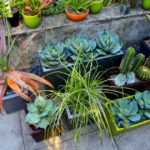
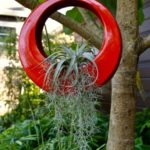



11 comments
A Touch of Discipline – ha! Nobody has ever accused me of discipline in the garden. Thank you Helen! As for mowing around the pavers I mow over them (we sunk them to be level with the soil, so the reel mower just glides right over) and then go back and edge with a half mood edger that belonged to my grandpa. I love the meditative, repetitive, motion.
The planters on sticks are my invention (more here: http://www.thedangergarden.com/2013/07/percolating.html) and yes, a funnel. Crazy right?
This was fun to see how my garden looked in the summer of ’14, thank you Helen! So many things have grown…and thanks to a severe winter many have died. Oh well…that’s gardening right!?
Don’t think of it as an accusation, Loree – you’re more disciplined than you give yourself credit for. But *just enough* and not a disc more. Thanks for the link (you are brilliant) and the added info. Yes, that’s gardening.
What a lot of great lessons you’ve pulled from Loree’s marvelous garden, Helen! I’ve had the pleasure of visiting her garden twice, and it’s always inspiring. She does indeed have “the eye.” From your picture of the blue agave in the red pot, I already know where I’m going to copy that in my own garden this spring.
Like Loree, I use stock tank troughs as planters (and a pond!) too. It’s a great way to introduce height in a garden bed, and there’s plenty of room for roots to grow. I always thought it was a particularly Texas look until I starting seeing them in PNW gardens too.
The dish planters on sticks that you mentioned were invented by Loree. She wrote a post about making them: http://www.thedangergarden.com/2013/07/percolating.html
Oh, you lucky thing! Yes, those colour combos bring out the best in each other, don’t they?
I will be investigating the feasibility of using stock tanks (thanks for the shorter name) for perennial plantings in our climate. Freeze-thaw cycles are the biggest enemy of containerized perennial roots in our region – and the potential for sogginess in spring with poor drainage. We’ll see what’s possible and report.
How wonderful to look through these garden photos again and again, sharing them and letting us all share the inspiration. I just love all the colors, many delightfully subtle in the foliage. Love those pots too.
I agree with everything you’ve said, Pat! Thanks for dropping by.
What a fabulous garden–and the perfect thing to look at while we clear out from 50+ cm of snow since Sunday night. I don’t think I’ve ever seen Loree’s site before but I must go visit it.
Oh, definitely! You must go visit the Danger Garden. Nice to see you here, too!
Completely bowled over. My usual preference is for lush and muddled but the straight lines here have won me over – a sense of order and elegant restraint without oppression. Neatness is sometimes too sterile but here each plant seems allowed a distinct home where its personal virtues are put in the spotlight. What an amazing garden!
P.S, I share your sorrow about the demise of Blotanical. Much missed.
Yes, that’s how we first met, Lucy!